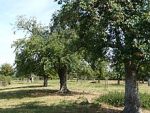 Perry is an alcoholic beverage made from pears, specifically perry pears, that are thought to be a hybrid of the cultivated pear, Pyrus communis subsp. commybis, and the wild pear, Pyrus communis subsp. pyraster. The ancient Roman naturalist, Pliny the Elder (AD 23/24 – 79) first mentioned the making a fermented drink from pears, but perry making is now common in France, England, and parts of the Commonwealth. The process of making the drink is similar to making apple cider but because pear juice contains signficant quantities of unfermentalbe sugar alcohols, particularly sorbitol, perry has more residual sweetness. In addition it is considered to be be lighter and drier than apple cider, have a floral/citrus aroma, and little pear taste. The alcohol contents runs 6-8%.
Perry is an alcoholic beverage made from pears, specifically perry pears, that are thought to be a hybrid of the cultivated pear, Pyrus communis subsp. commybis, and the wild pear, Pyrus communis subsp. pyraster. The ancient Roman naturalist, Pliny the Elder (AD 23/24 – 79) first mentioned the making a fermented drink from pears, but perry making is now common in France, England, and parts of the Commonwealth. The process of making the drink is similar to making apple cider but because pear juice contains signficant quantities of unfermentalbe sugar alcohols, particularly sorbitol, perry has more residual sweetness. In addition it is considered to be be lighter and drier than apple cider, have a floral/citrus aroma, and little pear taste. The alcohol contents runs 6-8%.
My paternal grandmother, Helen S. Wright, included a write up about perry in her 1909 book, Old Time Recipes for Home Made Wines. In the words of Grandmother Wright:
“Make this according to directions for apple cider*. Among the caricatures of the day (just after Perry’s victory on Lake Erie, 1813) was one representing John Bull in the person of the King, seated, wither his hand pressed uoon his stomach,indicating pain, which the fresh juice of the pear, called perry, will produce. This cariacture is entitled “Queen Charlotte and Johnny Bull got their dose of Perry.”‘
*Grandmother Wright has several recipes for cider, one of which is a fermented apple cider that she calls Devonshire Cider and may be the one she is referring to. In the words of my grandmother:
“The apples, after being plucked, are left in heaps in the orchard for some time, to complete their ripening, and render them more saccharine. They are then crushed between grooved cylinders, surmounted by a hopper, or in a circular trough, by two vertical edge-wheels of wood moved by a horse; after passing through which, they are received into large tubs or crocks, and are then called pomace. They are afterwards laid on the vat in alternate layers of the pomace and clean straw, called reeds. They are then pressed, a little water being occasionally added. The juice passes through a hair sieve, or similar strainer, and is received in a large vessel, whence it is run into casks or open vats, where everything held in mechanical suspension is deposited. The fermentation is often slow of being developed; though the juice be set in November or December, the working sometimes hardly commences till March. Till this time the cider is sweet; it now becomes pungent and vinous, and is ready to be racked for use. If the fermentation continue, it is usual to rack it again into a clean cask that has been well sulphured out, and to leave behind the head and sediment; or two or three cans of cider are put into a clean cask, and a match of brimstone burned in it. It is then agitated, by which the fermention of that quantity is completely stopped. The cask is then nearly filled, the fermention of the whole is checked, the process of racking is repeated until it becomes so, and is continued from time to time till the cider is in a quiet state and fit for drinking.”